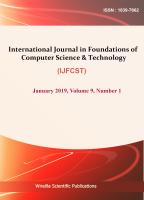Article,
PROBABILISTIC DIFFUSION IN RANDOM NETWORK GRAPHS
International Journal on Foundations of Computer Science & Technology (IJFCST), 5 (5): 7 (September 2015)
DOI: 10.5121/ijfcst.2015.5501
Abstract
In this paper, we consider a random network such that there could be a link between any two nodes in the
network with a certain probability (plink). Diffusion is the phenomenon of spreading information throughout
the network, starting from one or more initial set of nodes (called the early adopters). Information spreads
along the links with a certain probability (pdiff). Diffusion happens in rounds with the first round involving
the early adopters. The nodes that receive the information for the first time are said to be covered and
become candidates for diffusion in the subsequent round. Diffusion continues until all the nodes in the
network have received the information (successful diffusion) or there are no more candidate nodes to
spread the information but one or more nodes are yet to receive the information (diffusion failure). On the
basis of exhaustive simulations conducted in this paper, we observe that for a given plink and pdiff values, the
fraction of successful diffusion attempts does not appreciably change with increase in the number of early
adopters; whereas, the average number of rounds per successful diffusion attempt decreases with increase
in the number of early adopters. The invariant nature of the fraction of successful diffusion attempts with
increase in the number of early adopters for a random network (for fixed plink and pdiff values) is an
interesting and noteworthy observation (for further research) and it has not been hitherto reported in the
literature

